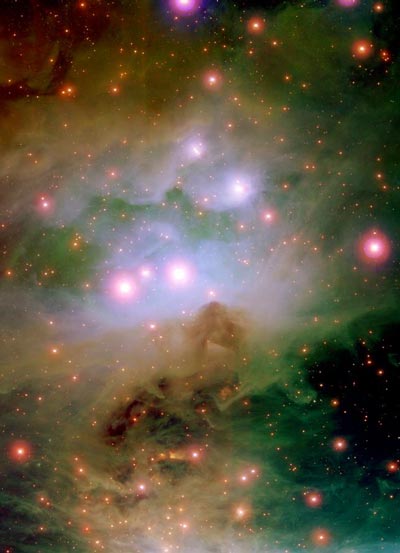Explanation: The Great Nebula in Orion is a colorful place. Visible to the unaided eye as a fuzzy patch in the constellation of Orion, this image taken with the Big Throughput Camera shows the Orion Nebula to be a busy neighborhood of young stars, hot gas, and dark dust. The power behind much of the Orion Nebula (M42) is the Trapezium - four of the brightest stars in the nebula. The eerie blue glow surrounding the bright stars pictured here is their own starlight reflected by nearby dust. Hot oxygen and hydrogen gases cause the extended green and pink glows, respectively. Dark brown dust filaments cover much of the region. The whole Orion Nebula cloud complex, which includes the Horsehead Nebula, will slowly disperse over the next 100,000 years.
1999 2000 2001 2002 2003 2004 2005 2006 2007 2008 2009 2010 2011 2012 2013 2014 2015 2016 2017 2018 2019 2020 2021 2022 2023 2024 2025 |
Yanvar' Fevral' Mart Aprel' Mai Iyun' Iyul' Avgust Sentyabr' Oktyabr' Noyabr' Dekabr' |
NASA Web Site Statements, Warnings, and Disclaimers
NASA Official: Jay Norris. Specific rights apply.
A service of: LHEA at NASA / GSFC
& Michigan Tech. U.
|
Publikacii s klyuchevymi slovami:
Orion Nebula - reflection nebula - shock wave - Tumannost' Oriona - Oblasti zvezdoobrazovaniya - rozhdenie zvezd - Rasseyannoe skoplenie - Trapeciya Oriona - tumannost' Konskaya Golova
Publikacii so slovami: Orion Nebula - reflection nebula - shock wave - Tumannost' Oriona - Oblasti zvezdoobrazovaniya - rozhdenie zvezd - Rasseyannoe skoplenie - Trapeciya Oriona - tumannost' Konskaya Golova | |
Sm. takzhe:
Vse publikacii na tu zhe temu >> | |
